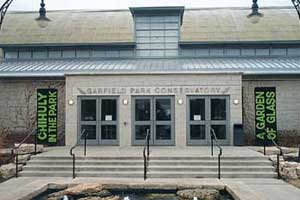It’s been asked, ‘does art imitate life?’–political science professor asks, ‘does art spark urban renewal?’
By Peter SchulerNews Office
 Chicago’s Garfield Park Conservatory welcomed overflow crowds to its yearlong “Chihuly in the Park: A Garden of Glass” exhibition. Melissa Harris-Lacewell studies how this arts event may have sparked positive changes in a neighborhood plagued by crime and unemployment. |
The works of Seattle-based glass artist Dale Chihuly, which graced the grounds of the Garfield Park Conservatory between November 2001 and November 2002, may have influenced many of the positive changes that have occurred in the East Garfield Park neighborhood of Chicago. That potential influence is one worth studying further, according to Melissa Harris-Lacewell, Assistant Professor in Political Science and the College, as it could be a source of valuable lessons for city officials and urban planners.
Under the aegis of the Harris School’s Cultural Policy Center, Harris-Lacewell is leading a team of researchers to use the unique exhibition to further explore how arts and culture can have a positive influence on community development.
Chihuly designed the exhibition to highlight both his own work and the vast plant collection at the 95-year-old conservatory. One of Chicago’s neglected gems, the conservatory is situated in an economically depressed and severely depopulated neighborhood with some of the city’s highest levels of unemployment and crime.
Harris-Lacewell noted that after decades of decline and neglect, both the East Garfield Park neighborhood and the conservatory itself had experienced a revival in the past few years. “By the time Chihuly’s sculptures took up temporary residence at the conservatory, there had been changes in the conservatory’s connection to the community, in the availability of transportation, in amenities offered to visitors, and in measures to promote safety,” Harris-Lacewell said.
 The Garfield Park Conservatory is served by the Chicago Transit Authority’s Green Line Homan station, which was relocated in 1999, two blocks west near the conservatory’s doorstep. |
Glowing press coverage for the “Chihuly in the Park: A Garden of Glass” exhibition was enhanced by word-of-mouth referrals, which resulted in overflow crowds more than four times the size of the conservatory’s usual monthly visitors.
“Although ‘Garden of Glass’ was unquestionably an artistic success, we need to ask the question whether it actually influenced the neighborhood that hosted it,” Harris-Lacewell said. The study will examine the relationship between the exhibition and the economic and social development of the poor and predominantly African-American East Garfield Park community.
Harris-Lacewell and her team will analyze data that includes public and leadership opinions that are being collected through surveys and focus group interviews with exhibition visitors and East Garfield Park residents, as well as key economic indicators and investigations of similar strategies that use art as a tool for development.
As part of this ongoing study, Harris-Lacewell and Nick Rabkin, executive director of Columbia College’s Chicago Center for Arts Policy, held a public discussion on Tuesday, Feb. 18, titled “The Lessons of the Chihuly Show,” at the University’s Gleacher Center. The presentation was part of the Cultural Policy Center’s “Discussion Series for Arts Professionals and Policymakers.”
The Packard Foundation and the Office of the Vice President of Community Affairs at the University provided funding for the first stage of the study.
![[Chronicle]](/images/sidebar_header_oct06.gif)